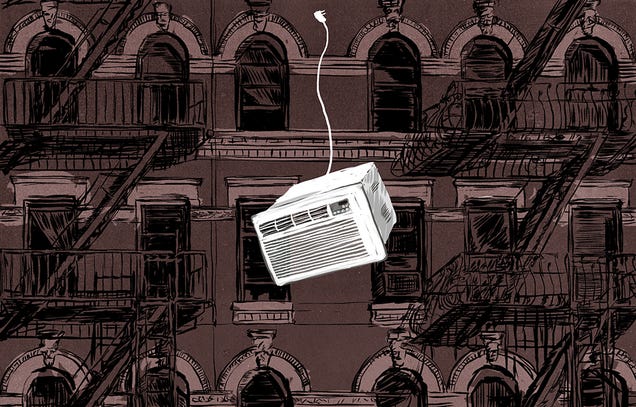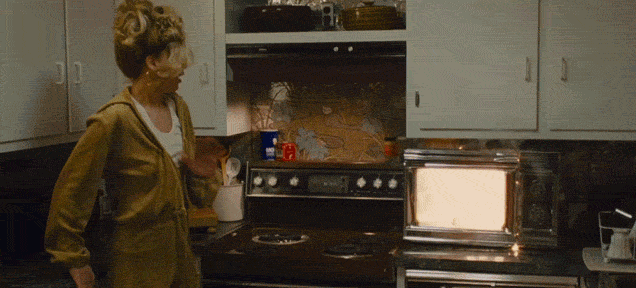![You Will Not Be Killed By Falling Air Conditioners]()
A few weeks ago, I accidentally pushed the air conditioning unit out of my bedroom window, sending it plunging down from the second story into the alleyway below. No one was harmed. Let me emphasize: It was an accident.
It was a Saturday. I remember because it was the day after an evening of post-work drinks in honor of Gawker Editor-in-Chief Max Read's birthday, which was on a Friday. I had a few drinks. I smoked a few cigarettes. Overall, a good night. I was woken up by the THUD! THUD! SPLASH! sound of rain pelting the air conditioner, which I had inherited from the room's previous tenant. This did not sound right to me. This sounded wrong and it sounded loud, and I wanted the noise to stop. "Why is this happening?" I rose from my bed and walked to the window to investigate. Maybe I could stop the noise.
This is the time of year when air conditioners are no longer cooling people's rooms, or drowning out the other noises in the night. People are removing, or thinking about removing, their air conditioners from the windows for the winter. Other people are worrying about being bludgeoned by those people's air conditioners.
Because of how quickly things happened, I cannot remember exactly what occurred next, but according to my best memory: I wiggled and futzed with the window holding the air conditioner ever so slightly, pushing it upward ever so delicately until... crash! There was nothing holding the air conditioner. There was no air conditioner. There was only an open window and wind spraying rain in my face.
I peeked my head out of the window to survey the carnage my clumsiness had wrought in the alley below. The air conditioner did not look good, but it was still mostly intact. Here's a picture of it after I hauled it to the curb in front of my building:
![You Will Not Be Killed By Falling Air Conditioners]()
Ouch.
I have told this story a few times. Each time, I am met with the following reactions from listeners: shock, awe, exasperation ("You could have killed someone!!!!!!"). Disapproval flickers in their eyes. But guess what? Any idiot, including this one, could very easily push their heavy box of metal that cools their room into the street below.
But I have good news. I have done my research in order to atone for my sin of stupidity. There is almost a zero percent chance that a falling air conditioner can kill you. Let me explain.
Yes, Someone Has Been Killed By a Falling Air Conditioner Before
I know. I just said the odds are minuscule. But the worst has happened in New York City: In 1988, the New York Times reports, 37-year-old Vito DeGiorgio died after an air conditioner fell seven stories from a building on East 23rd Street. DeGiorgio was hit at 1:20 p.m. and was pronounced dead at Bellevue Hospital about two hours later.
But it appears to have been a one-time freak accident resulting in death. With the Village Voice, Daily Intel, and Gothamist before me, in my web crawl of both Google and LexisNexis, I couldn't find another story about an A/C plummeting to the street and killing anyone. There have been a handful of reports of air conditioners falling from their perches and striking people below—but they all survived, obviously scathed. Let's run through them.
2006: East 104th Street
From Gothamist:
a 51 year old woman was hit by an air conditioner unit that fell out an East 104th Street window. The Post reports Lynda Kneish had been walking on the sidewalk when the AC tumbled from the third floor, and her "right leg was crushed, the bone shattered. She also suffered broken ribs, a broken pelvis, fractured vertebrae, and internal bleeding."
2010: 65 Second Ave.
From the Village Voice:
On what will go down in history as a very unlucky day for 67-year-old Tony Franzese, the poor man was just walking his Shih Tzu down 2nd Avenue at 3rd Street when he got bonked on the head with the errant A.C.
He reportedly suffered a head wound and was taken to Bellevue, where we're told he's in stable condition.
2012: 1780 First Ave.
From DNAinfo:
An air-conditioning unit came crashing down last week from a 20th-floor apartment of a public housing complex into a playground where nursery school children were playing, the school's director and New York City Housing Authority officials said.
2014: East 100th Street
From Daily Intel:
It happened again: A not-quite-stable A.C. unit, of which there are thousands and thousands constantly dangling above our heads, actually plummeted from a sixth-floor window, hitting an unsuspecting pedestrian in the head and injuring her leg. "It looked like hamburger meat, it was disgusting," said Chloe Pinkerton, a 28-year-old high school teacher, who had been training for the New York City Marathon.
The gloomy hope here is: While there are slightly higher odds of you being hit by a falling air conditioner, your chances of dying from that hit are comparatively nil.
Why Do Air Conditioners Fall?
This isn't a philosophical question. Air conditions fall because you push them. Or more likely: Your unit wasn't properly installed in the first place.
"I've never heard of one spontaneously falling, but I have heard of people throwing their windows up and them falling out. And people grab the cord at the last second and they're dangling in the air," Jonathan Berkson, proprietor of SuperCoolNYC Air Conditioners, told me. Berkson has been installing air conditioners in the city for five years and installed more than 200 this past summer.
Berkson told me that the only correct (and safe) image of an air conditioner in a window is one that has a metal bracket (or brackets) underneath it or is encased in a window cage (which you'll typically only see on municipal buildings like schools). But walk down just about any residential street in New York City, look up, and you will see air conditioners jutting from the windows of countless buildings, all propped up on their ledges by a variety of items: pieces of wood, bricks, scrap metal, stacks of old books, nothing.
Berkson, who obviously has a stake in saying so, told me most people underestimate how difficult it actually is to install an air conditioner—their weight distribution is weird, making it challenging to properly balance them in a window. Also, it's intimidating as fuck to install a 60-odd-pound metal box on a tiny window ledge seven, eight stories up from the street where people are innocently walking.
I've since learned that the air conditioner I inherited had been installed by the previous tenant "all by herself," which explains how easily it fell from the window.
Are There Laws Pertaining to Air Conditioner Installation?
Current regulation of window air conditioner units is a little hazy—unless you live in public housing. There are 334 public housing developments in New York, across a collective 2,600 buildings. Air conditioner installation, upkeep, and removal in those buildings are policed by the New York Public Housing Authority. And they're pretty diligent. From my email correspondence with them:
If a resident wants to get a major appliance such as an air conditioner, they must first contact the development office and sign a special appliance agreement. If a resident removes a window guard to install an air conditioner (A/C), they must also call the development office because NYCHA must inspect the window to see that the A/C is securely installed. To prevent accidents, all air conditioners must be properly braced and installed according to the manufacturer's installation specifications. If a resident intends to remove an air conditioner, he/she must notify us to arrange for an appointment. The resident cannot remove any air conditioner from any window unless a NYCHA maintenance worker is present to immediately replace the air conditioner with a window guard.
Moreover, NYCHA staff perform visual inspections of all apartments three times a year to ascertain those apartments that have missing, defective or improperly installed window guards or air conditioners.
If you don't live in public housing, then the laws and rules for air conditioners get a little trickier. As confirmed with a New York City Department of Buildings spokesman, New York City Local Law 11 is the only current legislation on the books that regulates the safety of window air conditioners—for buildings that are five stories or higher. "Air conditioner units must be bracketed to the manufacturer's specifications," the Dept. of Buildings spokesman told me.
But there are loopholes in Local Law 11 I believe have led to air conditioners to dangle in their current state over the city en masse: Buildings five stories or higher are required to be inspected at least every five years, more if someone files a complaint. If your improperly installed air conditioner causes your building to fail its inspection, then your building's owner or manager, not you, will be told to get the unit up to code.
Five years is a long time in the life of an apartment building: tenants come and go, new ownership can take over, etc. You can imagine that in those intervening years between inspections how many air conditioners are installed and removed from windows. Coupled with the diverted responsibility of the A/C unit's proper installation, it's no wonder so many look like they could fall at any second.
Which brings me to Local Law 11's second major loophole: You are not legally required to have your air conditioner installed by a professional (as you should). When I asked the Dept. of Buildings to clarify whether Local Law 11 stipulates that window air conditioners require professional installation, I was told that "the law doesn't specify." This loophole is closed in some buildings—especially newer ones and co-ops—where landlords and building managers will impose those requirements themselves. But otherwise, anyone is free to shove an A/C into a window however they can.
And they do: Berkson told me that he's been called to peoples' homes countless times to rework hack jobs performed by "someone from Craigslist they paid $50 to install their air conditioner." He's seen a lot of people stuff styrofoam all around their air conditioners to hold them in place.
So, Will a Falling Air Conditioner Kill Me?
The honest answer is yes, one can. But in the triage of anxieties one can have about living in New York, falling air conditioners should place well below being pushed onto the subway tracks and walking into an open grate in the sidewalk. The chances appear to be slim.
I asked Berkson if he thought the threat of falling air conditioners was real. "I don't think it's a real," he said. But he was willing to speculate. "However, if it was going to happen, it would probably be during peak times, like during a heatwave in June."
And when I tried to ask a representative at health and life insurance company Aetna (which, full disclosure, services healthcare benefits for a number of Gawker Media employees) about the number of accidental death claims they've received pegged to falling air conditioners, I was told they didn't have that data, presumably because they never, or very rarely, have. (Indeed, the poor Aetna rep I spoke with was downright puzzled by my question.)
Another, tangible way to ease your fears of your own air conditioner falling to the ground and killing someone is to suck it up and hire someone to install it on your window ledge—and then bug your friends to do the same.
[Illustration by Jim Cooke]



























